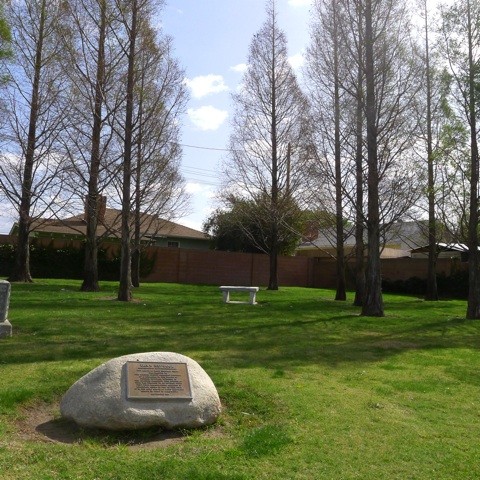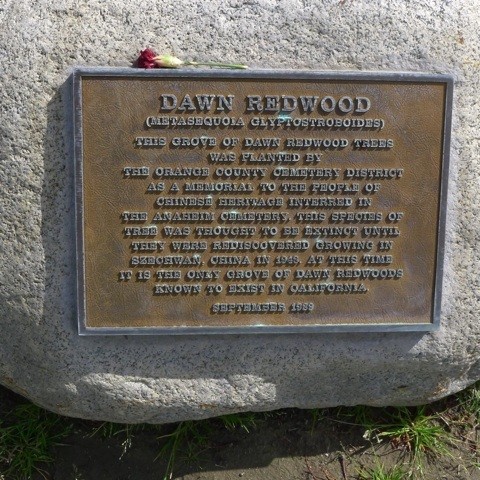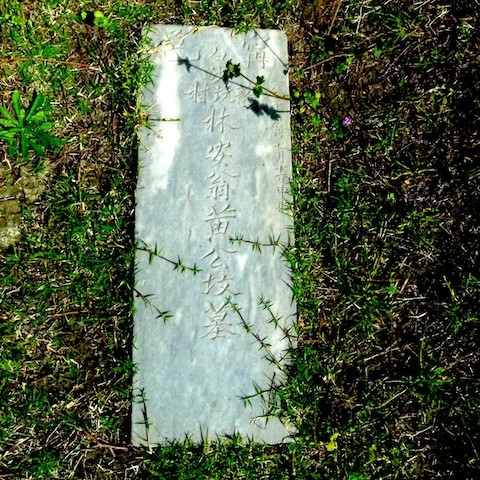
Among the many jewels in OC's collection of body depositories, Anaheim Cemetery is perhaps the shiniest. Established in 1866, its soil is fertilized by the area's earliest pioneers. Home to the first public mausoleum on the west coast, (take that, Rose Hills), its garden of crooked headstones counts Rev. Lemuel Webber, founder of Westminster among its tenants. Several family vaults, no longer visited by relatives, are padlocked, but the buildings' exteriors exhibit gorgeous architecture in varying styles, some adorned with stained glass windows.
]

Ownership of the property changed hands more than once through the years until 1985 when it was consolidated with two other parks–El Toro Memorial Park and Santa Ana Cemetery— under the management of the Orange County Cemetery District.
An Unsolved Mystery
Ironically, one section of the park, located along the property's south east corner, may contain no human remains at all. Here, removed from the ornate slabs, obelisks and statues is a small grove of Dawn Redwood Trees hailing from the Sichuan-Hubei region of China. They were planted by the cemetery district in 1989 to commemorate the Chinese pioneers once–and possibly still–buried here.
Aside from one rectangular marble marker engraved with Chinese figures, there are no grave stones in this section. It is believed there were 33 Chinese burials conducted here before and after the turn of the century, but the original graves, made of wood, were burned decades ago by cemetery caretakers who used fire to eradicate weeds.
Adding to the mystery is the inhabitants' final wish that their bodies be disinterred, and shipped to China for reburial. According to Orange County Cemetery District Trustee Cynthia Ward, this was done because early Chinese immigrants felt it disrespectful to leave their remains in American soil.
While records of the initial burials exist, records of disinterments do not.
“If they kept records of the disinterments, they didn't pass them along to us,” said Ward. “I'd be really interested in knowing. But even if we found this area to be empty, I can't see us using it. [The Chinese] played an important part in the development of Anaheim, and we can't forget that.”
Erasing History
Anaheim, like many California cities in the late 1800s, had its own Chinatown. Maps of the era show Chinese-owned buildings clustered around what is now Lincoln Avenue and Anaheim Boulevard. But like the graves in the cemetery, these buildings have long been erased.
An August 1924 issue of the Anaheim Daily Gazette wrote about a health department inspection of the structures.
“After investigating the buildings some days ago,” the paper reads, “the board of health decided they were a menace to the health of the community and should be demolished.”
Earlier articles abound with accounts of discrimination against Chinese laborers which remind one of today's anti-Latino hysteria. In 1877, local pioneers told rancher J.B. Raine not to hire Chinese laborers to pick his hop crops. When he hired Chinese anyway, raids were launched on the work camp and Chinese dwellings were torn down. When Raine hired whites instead of Chinese, it was reported several worked a few days before striking out for higher wages.
Near Westminster, Chinese workers hired by the Earl Fruit Company saw their dwellings burned by marauders while they slept. After escaping the flaming buildings, they were shot at.
It's hard to imagine why they would have wanted to be buried in China.
Digging Up the Past
Those curious about Anaheim Cemetery burials can examine a list in the Orange County Archives. A three-ring binder holds computer generated sheets with lines of names, and dates: 78-year-old Ting Sung Lee, buried 1907, an unknown Chinese infant buried 1877, 38-year-old Sin Lee buried in 1880.

As for the one marker remaining in the Chinese section, the Weekly contacted Cal State Long Beach Professor of Asian Studies, Dr. Tim Xie. After examining a photo of the marker, he said the inscription marks the tomb of Mr. Lin'an Huang from Huxun Village (near the current province of Henan.), buried in the Genxu year, (most likely 1910.)
Perhaps Mr. Huang is still buried here. We may never know.
Going Home
Finding relief from the blazing sun one afternoon in the tall grove of Redwood trees, Cynthia Ward says Anaheim cemetery is a place she appreciates for the perspective it offers. Monuments with dates more than a hundred old will have that effect. But she points out that the spots on the lawn without grave stones also have stories to tell.
“Here's an entire population of people far from home and their last request was to have their bones sent home. Their loved ones would scrimp and save and go without. I wish I knew how many went home,” she says. “I'd like to think they all made it.”

